Managing Project Teams: Analysis of Mount Everest Simulation Report
VerifiedAdded on 2023/06/09
|22
|6593
|485
Report
AI Summary
This report critically analyzes a student's experience in the Mount Everest simulation, focusing on team dynamics, leadership, and communication. The student's team, composed of diverse individuals, participated in the simulation, highlighting the importance of effective teamwork, leadership styles, and communication strategies. The report delves into team conflicts, team-building exercises, and conflict resolution methods. It also explores various leadership roles, qualities, and styles, including contemporary theories such as transactional, transformational, and charismatic leadership. Furthermore, the report examines communication challenges and recommendations within the context of the simulation, drawing conclusions about lessons learned and offering recommendations for leading projects and being part of a project team. Appendices include simulation results and team contracts.
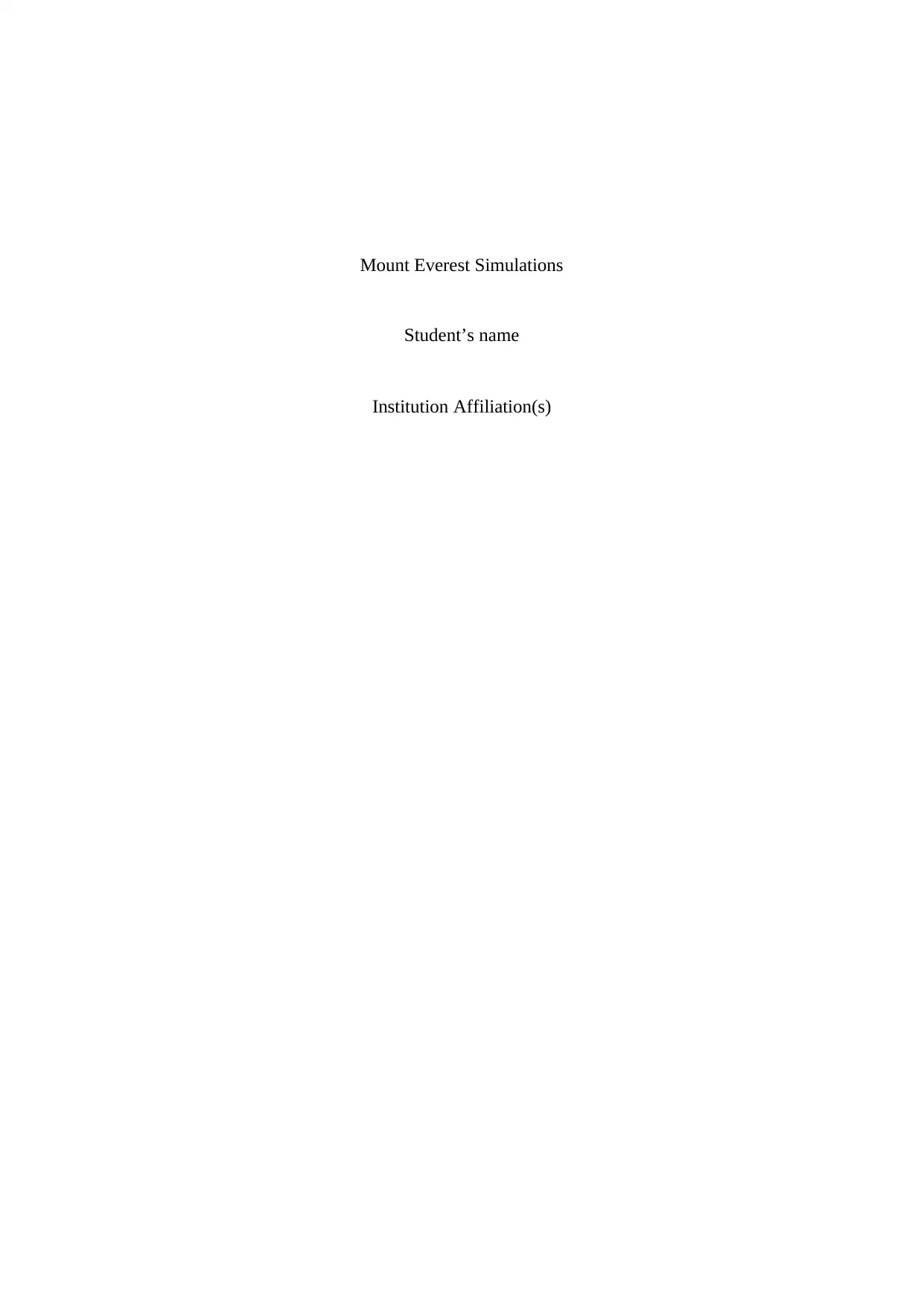
Mount Everest Simulations
Student’s name
Institution Affiliation(s)
Student’s name
Institution Affiliation(s)
Paraphrase This Document
Need a fresh take? Get an instant paraphrase of this document with our AI Paraphraser
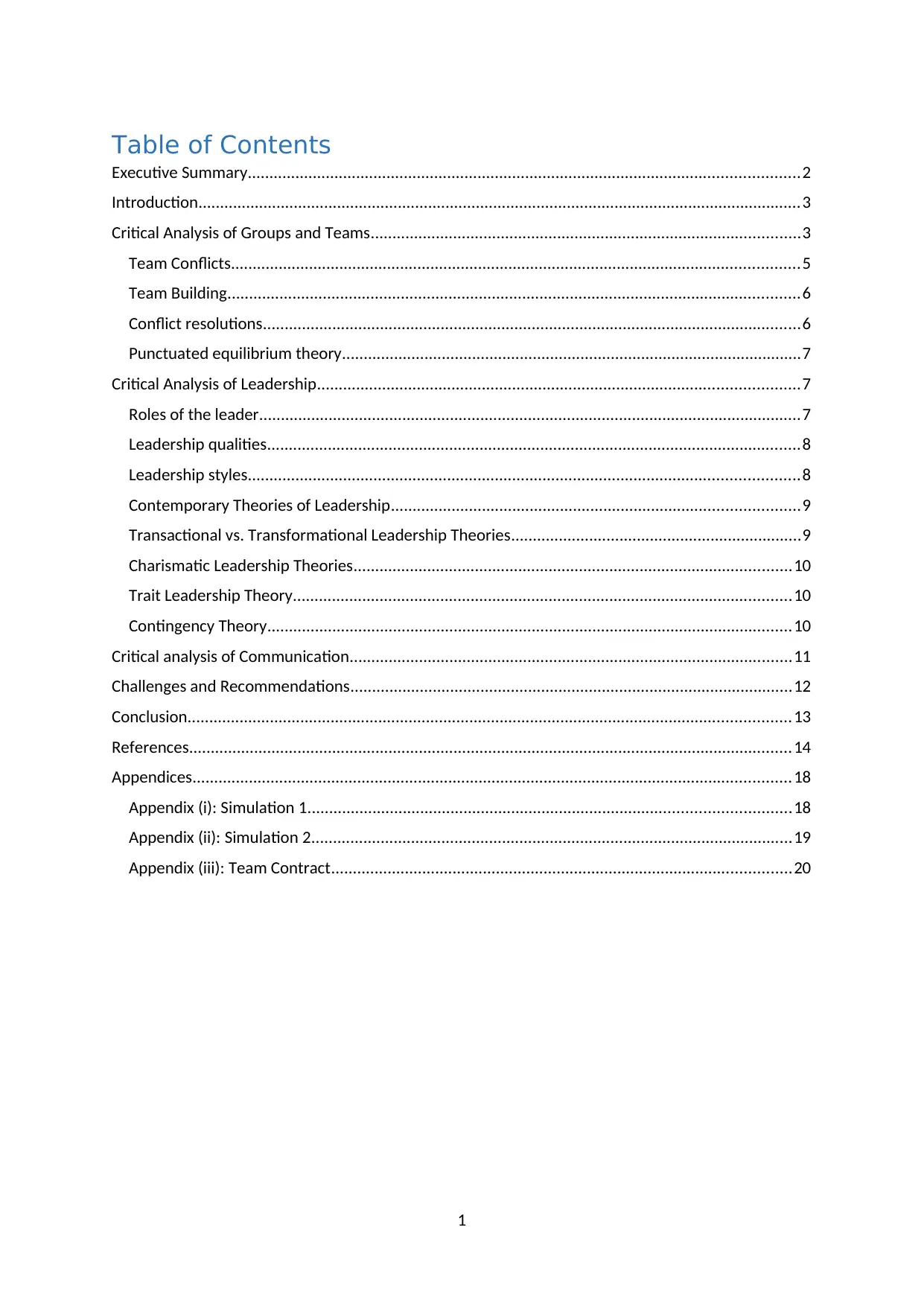
Table of Contents
Executive Summary...............................................................................................................................2
Introduction...........................................................................................................................................3
Critical Analysis of Groups and Teams...................................................................................................3
Team Conflicts...................................................................................................................................5
Team Building....................................................................................................................................6
Conflict resolutions............................................................................................................................6
Punctuated equilibrium theory..........................................................................................................7
Critical Analysis of Leadership...............................................................................................................7
Roles of the leader.............................................................................................................................7
Leadership qualities...........................................................................................................................8
Leadership styles...............................................................................................................................8
Contemporary Theories of Leadership..............................................................................................9
Transactional vs. Transformational Leadership Theories...................................................................9
Charismatic Leadership Theories.....................................................................................................10
Trait Leadership Theory...................................................................................................................10
Contingency Theory.........................................................................................................................10
Critical analysis of Communication......................................................................................................11
Challenges and Recommendations......................................................................................................12
Conclusion...........................................................................................................................................13
References...........................................................................................................................................14
Appendices..........................................................................................................................................18
Appendix (i): Simulation 1...............................................................................................................18
Appendix (ii): Simulation 2...............................................................................................................19
Appendix (iii): Team Contract..........................................................................................................20
1
Executive Summary...............................................................................................................................2
Introduction...........................................................................................................................................3
Critical Analysis of Groups and Teams...................................................................................................3
Team Conflicts...................................................................................................................................5
Team Building....................................................................................................................................6
Conflict resolutions............................................................................................................................6
Punctuated equilibrium theory..........................................................................................................7
Critical Analysis of Leadership...............................................................................................................7
Roles of the leader.............................................................................................................................7
Leadership qualities...........................................................................................................................8
Leadership styles...............................................................................................................................8
Contemporary Theories of Leadership..............................................................................................9
Transactional vs. Transformational Leadership Theories...................................................................9
Charismatic Leadership Theories.....................................................................................................10
Trait Leadership Theory...................................................................................................................10
Contingency Theory.........................................................................................................................10
Critical analysis of Communication......................................................................................................11
Challenges and Recommendations......................................................................................................12
Conclusion...........................................................................................................................................13
References...........................................................................................................................................14
Appendices..........................................................................................................................................18
Appendix (i): Simulation 1...............................................................................................................18
Appendix (ii): Simulation 2...............................................................................................................19
Appendix (iii): Team Contract..........................................................................................................20
1
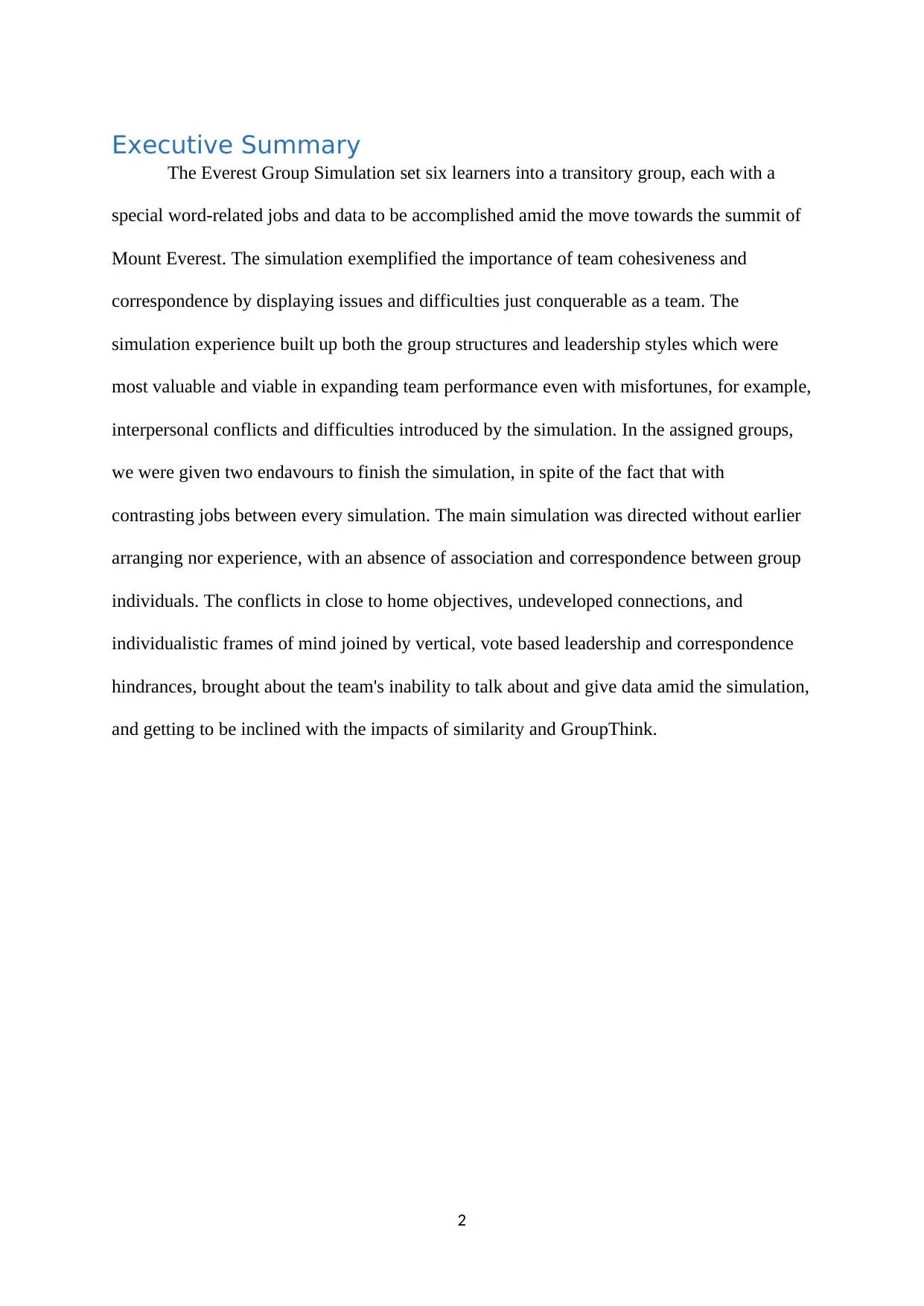
Executive Summary
The Everest Group Simulation set six learners into a transitory group, each with a
special word-related jobs and data to be accomplished amid the move towards the summit of
Mount Everest. The simulation exemplified the importance of team cohesiveness and
correspondence by displaying issues and difficulties just conquerable as a team. The
simulation experience built up both the group structures and leadership styles which were
most valuable and viable in expanding team performance even with misfortunes, for example,
interpersonal conflicts and difficulties introduced by the simulation. In the assigned groups,
we were given two endavours to finish the simulation, in spite of the fact that with
contrasting jobs between every simulation. The main simulation was directed without earlier
arranging nor experience, with an absence of association and correspondence between group
individuals. The conflicts in close to home objectives, undeveloped connections, and
individualistic frames of mind joined by vertical, vote based leadership and correspondence
hindrances, brought about the team's inability to talk about and give data amid the simulation,
and getting to be inclined with the impacts of similarity and GroupThink.
2
The Everest Group Simulation set six learners into a transitory group, each with a
special word-related jobs and data to be accomplished amid the move towards the summit of
Mount Everest. The simulation exemplified the importance of team cohesiveness and
correspondence by displaying issues and difficulties just conquerable as a team. The
simulation experience built up both the group structures and leadership styles which were
most valuable and viable in expanding team performance even with misfortunes, for example,
interpersonal conflicts and difficulties introduced by the simulation. In the assigned groups,
we were given two endavours to finish the simulation, in spite of the fact that with
contrasting jobs between every simulation. The main simulation was directed without earlier
arranging nor experience, with an absence of association and correspondence between group
individuals. The conflicts in close to home objectives, undeveloped connections, and
individualistic frames of mind joined by vertical, vote based leadership and correspondence
hindrances, brought about the team's inability to talk about and give data amid the simulation,
and getting to be inclined with the impacts of similarity and GroupThink.
2
⊘ This is a preview!⊘
Do you want full access?
Subscribe today to unlock all pages.

Trusted by 1+ million students worldwide
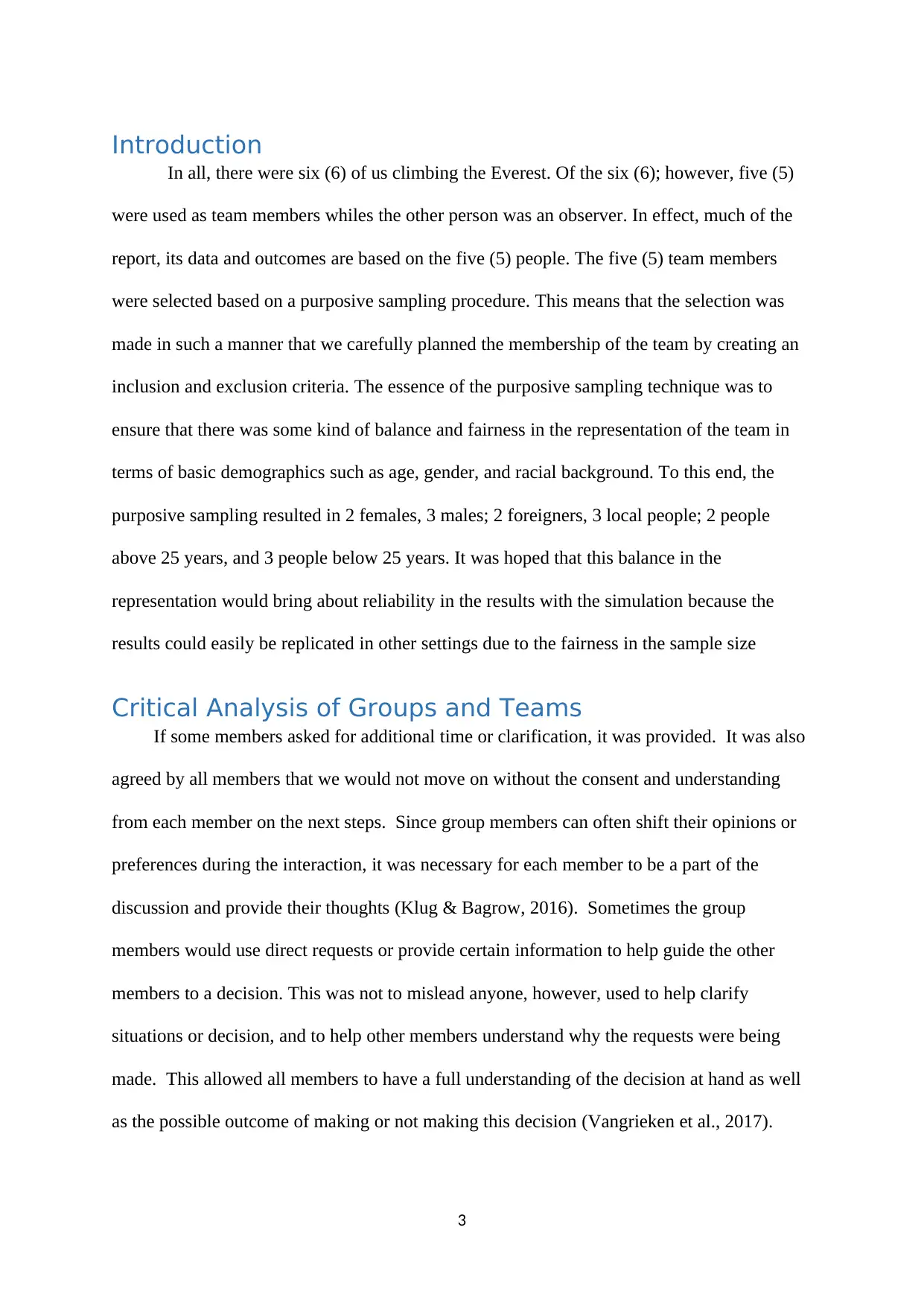
Introduction
In all, there were six (6) of us climbing the Everest. Of the six (6); however, five (5)
were used as team members whiles the other person was an observer. In effect, much of the
report, its data and outcomes are based on the five (5) people. The five (5) team members
were selected based on a purposive sampling procedure. This means that the selection was
made in such a manner that we carefully planned the membership of the team by creating an
inclusion and exclusion criteria. The essence of the purposive sampling technique was to
ensure that there was some kind of balance and fairness in the representation of the team in
terms of basic demographics such as age, gender, and racial background. To this end, the
purposive sampling resulted in 2 females, 3 males; 2 foreigners, 3 local people; 2 people
above 25 years, and 3 people below 25 years. It was hoped that this balance in the
representation would bring about reliability in the results with the simulation because the
results could easily be replicated in other settings due to the fairness in the sample size
Critical Analysis of Groups and Teams
If some members asked for additional time or clarification, it was provided. It was also
agreed by all members that we would not move on without the consent and understanding
from each member on the next steps. Since group members can often shift their opinions or
preferences during the interaction, it was necessary for each member to be a part of the
discussion and provide their thoughts (Klug & Bagrow, 2016). Sometimes the group
members would use direct requests or provide certain information to help guide the other
members to a decision. This was not to mislead anyone, however, used to help clarify
situations or decision, and to help other members understand why the requests were being
made. This allowed all members to have a full understanding of the decision at hand as well
as the possible outcome of making or not making this decision (Vangrieken et al., 2017).
3
In all, there were six (6) of us climbing the Everest. Of the six (6); however, five (5)
were used as team members whiles the other person was an observer. In effect, much of the
report, its data and outcomes are based on the five (5) people. The five (5) team members
were selected based on a purposive sampling procedure. This means that the selection was
made in such a manner that we carefully planned the membership of the team by creating an
inclusion and exclusion criteria. The essence of the purposive sampling technique was to
ensure that there was some kind of balance and fairness in the representation of the team in
terms of basic demographics such as age, gender, and racial background. To this end, the
purposive sampling resulted in 2 females, 3 males; 2 foreigners, 3 local people; 2 people
above 25 years, and 3 people below 25 years. It was hoped that this balance in the
representation would bring about reliability in the results with the simulation because the
results could easily be replicated in other settings due to the fairness in the sample size
Critical Analysis of Groups and Teams
If some members asked for additional time or clarification, it was provided. It was also
agreed by all members that we would not move on without the consent and understanding
from each member on the next steps. Since group members can often shift their opinions or
preferences during the interaction, it was necessary for each member to be a part of the
discussion and provide their thoughts (Klug & Bagrow, 2016). Sometimes the group
members would use direct requests or provide certain information to help guide the other
members to a decision. This was not to mislead anyone, however, used to help clarify
situations or decision, and to help other members understand why the requests were being
made. This allowed all members to have a full understanding of the decision at hand as well
as the possible outcome of making or not making this decision (Vangrieken et al., 2017).
3
Paraphrase This Document
Need a fresh take? Get an instant paraphrase of this document with our AI Paraphraser
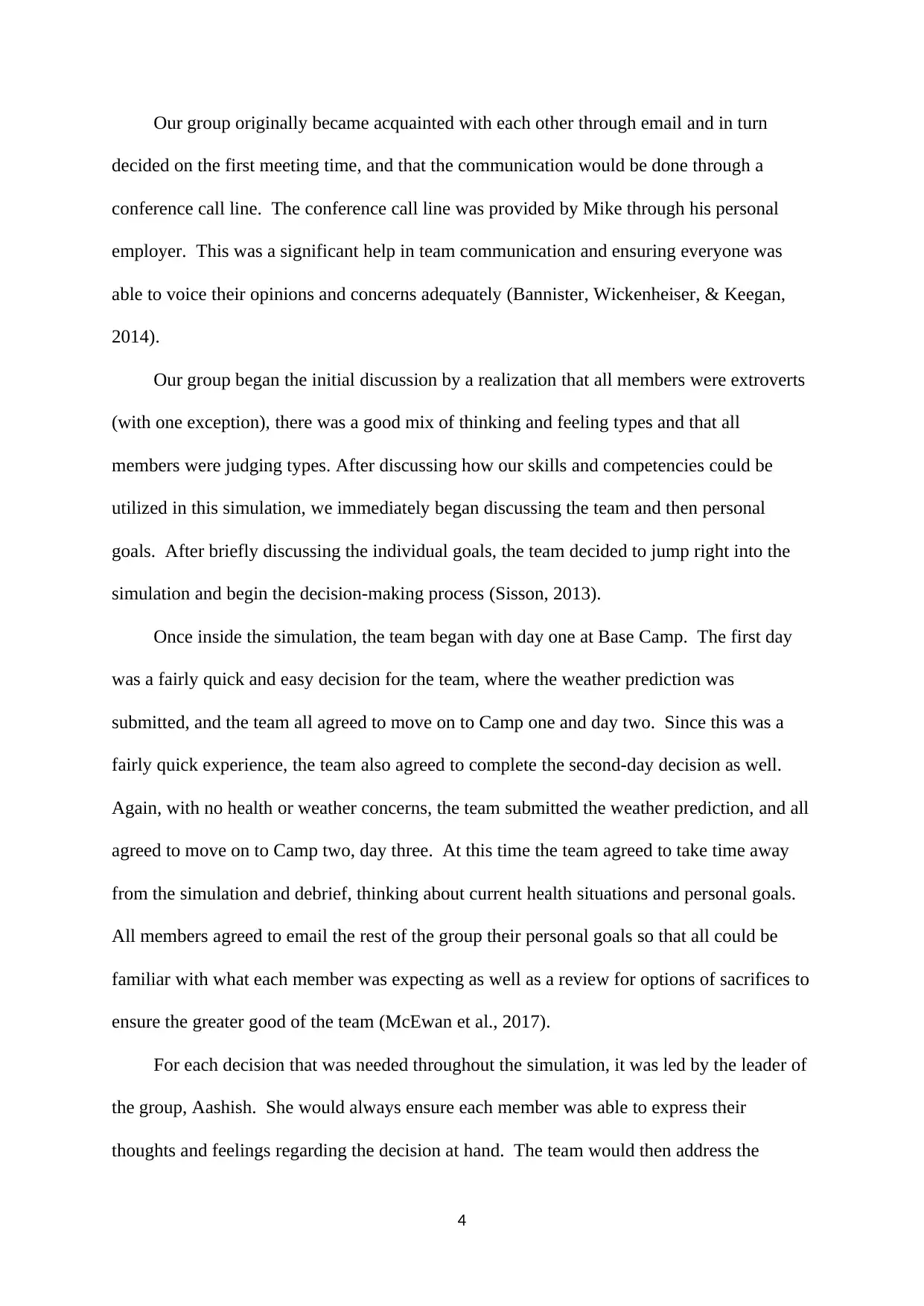
Our group originally became acquainted with each other through email and in turn
decided on the first meeting time, and that the communication would be done through a
conference call line. The conference call line was provided by Mike through his personal
employer. This was a significant help in team communication and ensuring everyone was
able to voice their opinions and concerns adequately (Bannister, Wickenheiser, & Keegan,
2014).
Our group began the initial discussion by a realization that all members were extroverts
(with one exception), there was a good mix of thinking and feeling types and that all
members were judging types. After discussing how our skills and competencies could be
utilized in this simulation, we immediately began discussing the team and then personal
goals. After briefly discussing the individual goals, the team decided to jump right into the
simulation and begin the decision-making process (Sisson, 2013).
Once inside the simulation, the team began with day one at Base Camp. The first day
was a fairly quick and easy decision for the team, where the weather prediction was
submitted, and the team all agreed to move on to Camp one and day two. Since this was a
fairly quick experience, the team also agreed to complete the second-day decision as well.
Again, with no health or weather concerns, the team submitted the weather prediction, and all
agreed to move on to Camp two, day three. At this time the team agreed to take time away
from the simulation and debrief, thinking about current health situations and personal goals.
All members agreed to email the rest of the group their personal goals so that all could be
familiar with what each member was expecting as well as a review for options of sacrifices to
ensure the greater good of the team (McEwan et al., 2017).
For each decision that was needed throughout the simulation, it was led by the leader of
the group, Aashish. She would always ensure each member was able to express their
thoughts and feelings regarding the decision at hand. The team would then address the
4
decided on the first meeting time, and that the communication would be done through a
conference call line. The conference call line was provided by Mike through his personal
employer. This was a significant help in team communication and ensuring everyone was
able to voice their opinions and concerns adequately (Bannister, Wickenheiser, & Keegan,
2014).
Our group began the initial discussion by a realization that all members were extroverts
(with one exception), there was a good mix of thinking and feeling types and that all
members were judging types. After discussing how our skills and competencies could be
utilized in this simulation, we immediately began discussing the team and then personal
goals. After briefly discussing the individual goals, the team decided to jump right into the
simulation and begin the decision-making process (Sisson, 2013).
Once inside the simulation, the team began with day one at Base Camp. The first day
was a fairly quick and easy decision for the team, where the weather prediction was
submitted, and the team all agreed to move on to Camp one and day two. Since this was a
fairly quick experience, the team also agreed to complete the second-day decision as well.
Again, with no health or weather concerns, the team submitted the weather prediction, and all
agreed to move on to Camp two, day three. At this time the team agreed to take time away
from the simulation and debrief, thinking about current health situations and personal goals.
All members agreed to email the rest of the group their personal goals so that all could be
familiar with what each member was expecting as well as a review for options of sacrifices to
ensure the greater good of the team (McEwan et al., 2017).
For each decision that was needed throughout the simulation, it was led by the leader of
the group, Aashish. She would always ensure each member was able to express their
thoughts and feelings regarding the decision at hand. The team would then address the
4
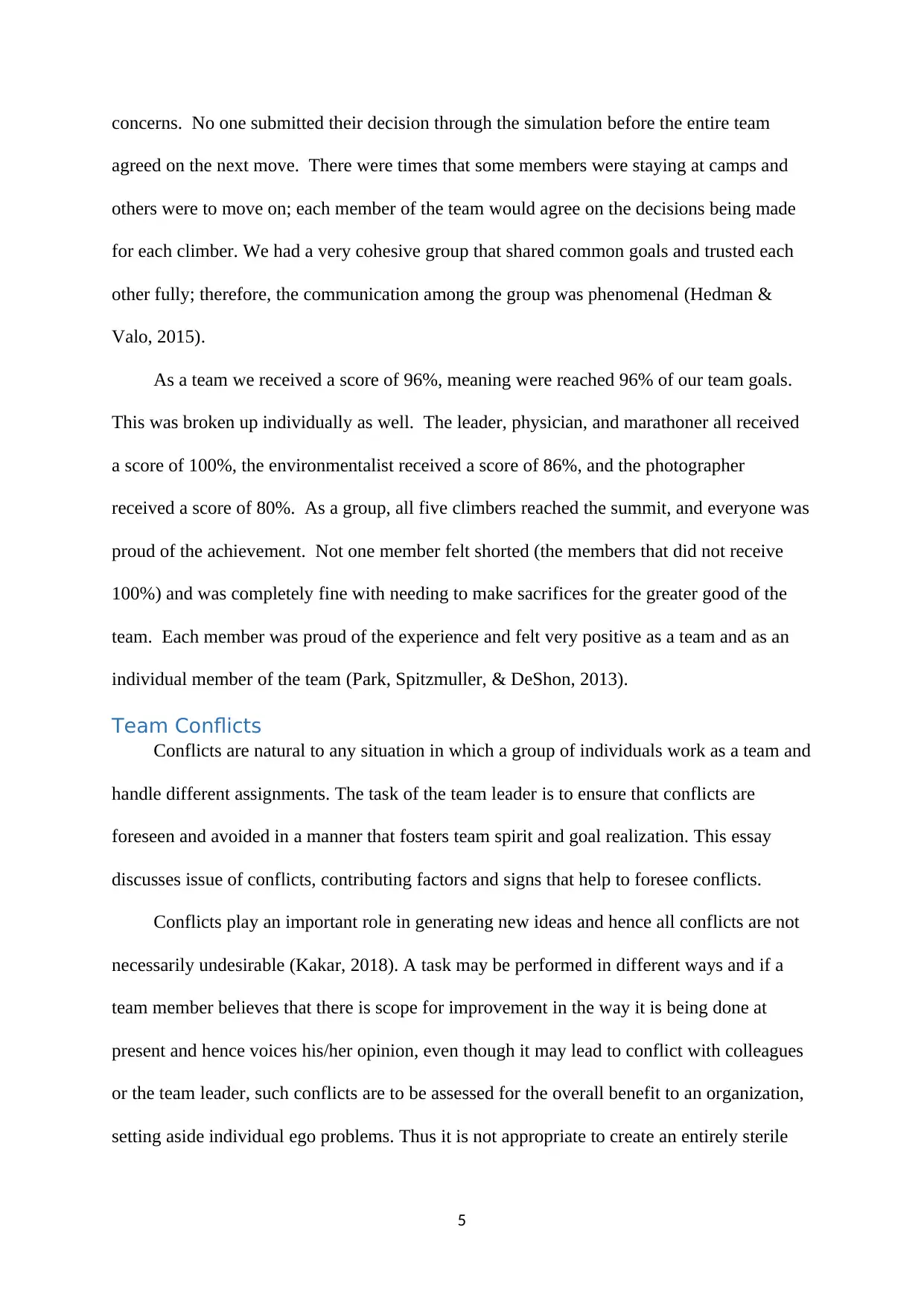
concerns. No one submitted their decision through the simulation before the entire team
agreed on the next move. There were times that some members were staying at camps and
others were to move on; each member of the team would agree on the decisions being made
for each climber. We had a very cohesive group that shared common goals and trusted each
other fully; therefore, the communication among the group was phenomenal (Hedman &
Valo, 2015).
As a team we received a score of 96%, meaning were reached 96% of our team goals.
This was broken up individually as well. The leader, physician, and marathoner all received
a score of 100%, the environmentalist received a score of 86%, and the photographer
received a score of 80%. As a group, all five climbers reached the summit, and everyone was
proud of the achievement. Not one member felt shorted (the members that did not receive
100%) and was completely fine with needing to make sacrifices for the greater good of the
team. Each member was proud of the experience and felt very positive as a team and as an
individual member of the team (Park, Spitzmuller, & DeShon, 2013).
Team Conflicts
Conflicts are natural to any situation in which a group of individuals work as a team and
handle different assignments. The task of the team leader is to ensure that conflicts are
foreseen and avoided in a manner that fosters team spirit and goal realization. This essay
discusses issue of conflicts, contributing factors and signs that help to foresee conflicts.
Conflicts play an important role in generating new ideas and hence all conflicts are not
necessarily undesirable (Kakar, 2018). A task may be performed in different ways and if a
team member believes that there is scope for improvement in the way it is being done at
present and hence voices his/her opinion, even though it may lead to conflict with colleagues
or the team leader, such conflicts are to be assessed for the overall benefit to an organization,
setting aside individual ego problems. Thus it is not appropriate to create an entirely sterile
5
agreed on the next move. There were times that some members were staying at camps and
others were to move on; each member of the team would agree on the decisions being made
for each climber. We had a very cohesive group that shared common goals and trusted each
other fully; therefore, the communication among the group was phenomenal (Hedman &
Valo, 2015).
As a team we received a score of 96%, meaning were reached 96% of our team goals.
This was broken up individually as well. The leader, physician, and marathoner all received
a score of 100%, the environmentalist received a score of 86%, and the photographer
received a score of 80%. As a group, all five climbers reached the summit, and everyone was
proud of the achievement. Not one member felt shorted (the members that did not receive
100%) and was completely fine with needing to make sacrifices for the greater good of the
team. Each member was proud of the experience and felt very positive as a team and as an
individual member of the team (Park, Spitzmuller, & DeShon, 2013).
Team Conflicts
Conflicts are natural to any situation in which a group of individuals work as a team and
handle different assignments. The task of the team leader is to ensure that conflicts are
foreseen and avoided in a manner that fosters team spirit and goal realization. This essay
discusses issue of conflicts, contributing factors and signs that help to foresee conflicts.
Conflicts play an important role in generating new ideas and hence all conflicts are not
necessarily undesirable (Kakar, 2018). A task may be performed in different ways and if a
team member believes that there is scope for improvement in the way it is being done at
present and hence voices his/her opinion, even though it may lead to conflict with colleagues
or the team leader, such conflicts are to be assessed for the overall benefit to an organization,
setting aside individual ego problems. Thus it is not appropriate to create an entirely sterile
5
⊘ This is a preview!⊘
Do you want full access?
Subscribe today to unlock all pages.

Trusted by 1+ million students worldwide
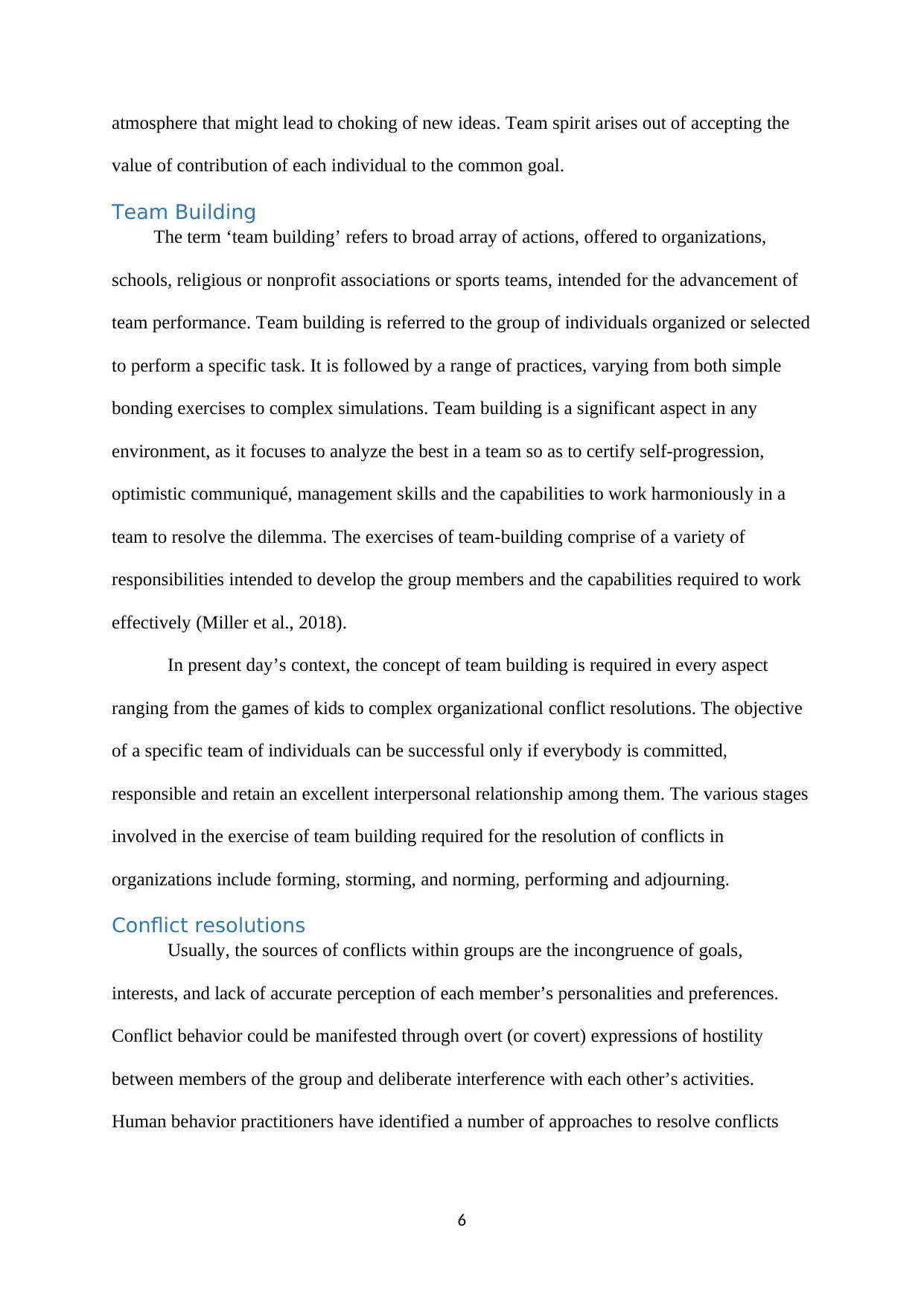
atmosphere that might lead to choking of new ideas. Team spirit arises out of accepting the
value of contribution of each individual to the common goal.
Team Building
The term ‘team building’ refers to broad array of actions, offered to organizations,
schools, religious or nonprofit associations or sports teams, intended for the advancement of
team performance. Team building is referred to the group of individuals organized or selected
to perform a specific task. It is followed by a range of practices, varying from both simple
bonding exercises to complex simulations. Team building is a significant aspect in any
environment, as it focuses to analyze the best in a team so as to certify self-progression,
optimistic communiqué, management skills and the capabilities to work harmoniously in a
team to resolve the dilemma. The exercises of team-building comprise of a variety of
responsibilities intended to develop the group members and the capabilities required to work
effectively (Miller et al., 2018).
In present day’s context, the concept of team building is required in every aspect
ranging from the games of kids to complex organizational conflict resolutions. The objective
of a specific team of individuals can be successful only if everybody is committed,
responsible and retain an excellent interpersonal relationship among them. The various stages
involved in the exercise of team building required for the resolution of conflicts in
organizations include forming, storming, and norming, performing and adjourning.
Conflict resolutions
Usually, the sources of conflicts within groups are the incongruence of goals,
interests, and lack of accurate perception of each member’s personalities and preferences.
Conflict behavior could be manifested through overt (or covert) expressions of hostility
between members of the group and deliberate interference with each other’s activities.
Human behavior practitioners have identified a number of approaches to resolve conflicts
6
value of contribution of each individual to the common goal.
Team Building
The term ‘team building’ refers to broad array of actions, offered to organizations,
schools, religious or nonprofit associations or sports teams, intended for the advancement of
team performance. Team building is referred to the group of individuals organized or selected
to perform a specific task. It is followed by a range of practices, varying from both simple
bonding exercises to complex simulations. Team building is a significant aspect in any
environment, as it focuses to analyze the best in a team so as to certify self-progression,
optimistic communiqué, management skills and the capabilities to work harmoniously in a
team to resolve the dilemma. The exercises of team-building comprise of a variety of
responsibilities intended to develop the group members and the capabilities required to work
effectively (Miller et al., 2018).
In present day’s context, the concept of team building is required in every aspect
ranging from the games of kids to complex organizational conflict resolutions. The objective
of a specific team of individuals can be successful only if everybody is committed,
responsible and retain an excellent interpersonal relationship among them. The various stages
involved in the exercise of team building required for the resolution of conflicts in
organizations include forming, storming, and norming, performing and adjourning.
Conflict resolutions
Usually, the sources of conflicts within groups are the incongruence of goals,
interests, and lack of accurate perception of each member’s personalities and preferences.
Conflict behavior could be manifested through overt (or covert) expressions of hostility
between members of the group and deliberate interference with each other’s activities.
Human behavior practitioners have identified a number of approaches to resolve conflicts
6
Paraphrase This Document
Need a fresh take? Get an instant paraphrase of this document with our AI Paraphraser
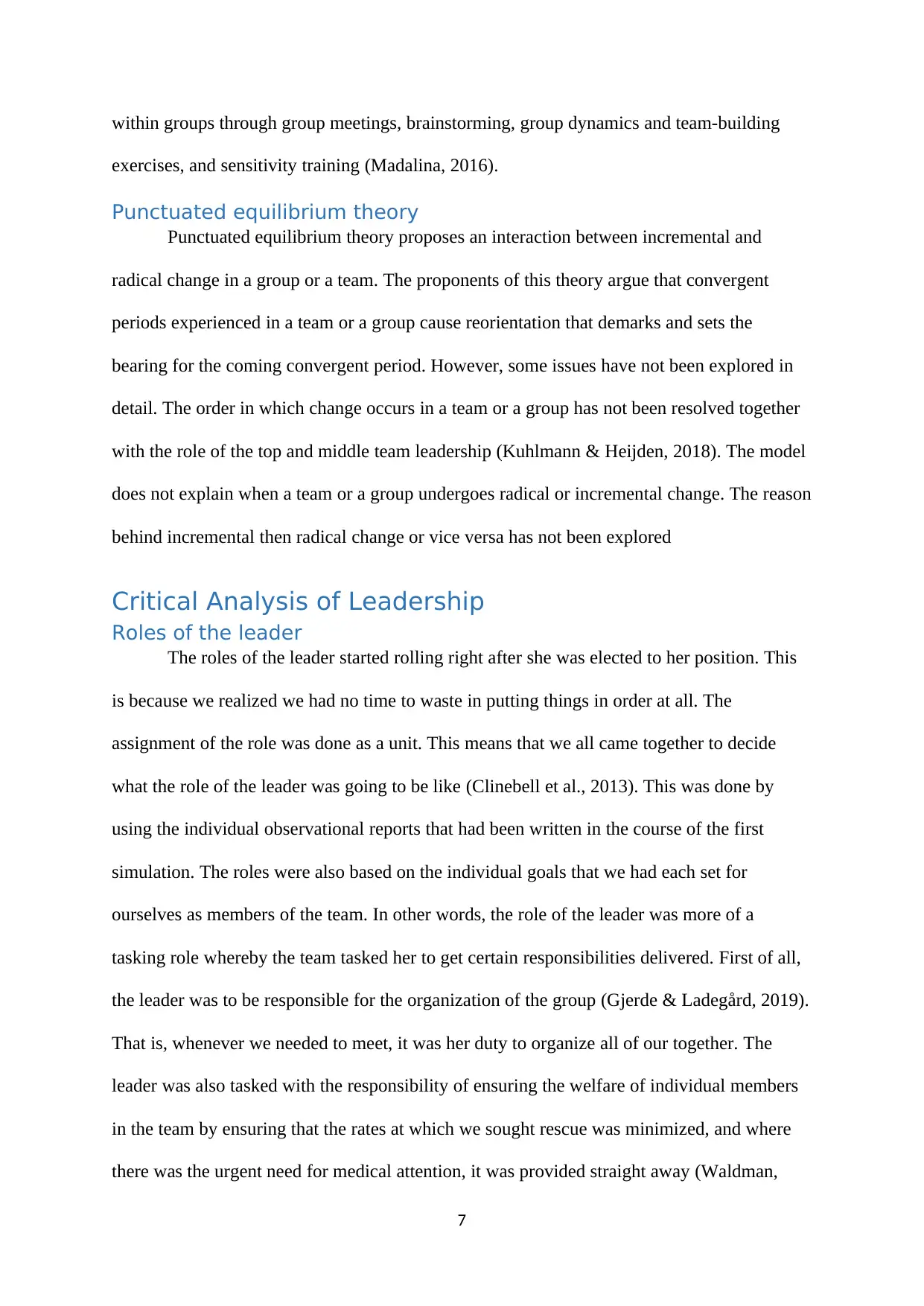
within groups through group meetings, brainstorming, group dynamics and team-building
exercises, and sensitivity training (Madalina, 2016).
Punctuated equilibrium theory
Punctuated equilibrium theory proposes an interaction between incremental and
radical change in a group or a team. The proponents of this theory argue that convergent
periods experienced in a team or a group cause reorientation that demarks and sets the
bearing for the coming convergent period. However, some issues have not been explored in
detail. The order in which change occurs in a team or a group has not been resolved together
with the role of the top and middle team leadership (Kuhlmann & Heijden, 2018). The model
does not explain when a team or a group undergoes radical or incremental change. The reason
behind incremental then radical change or vice versa has not been explored
Critical Analysis of Leadership
Roles of the leader
The roles of the leader started rolling right after she was elected to her position. This
is because we realized we had no time to waste in putting things in order at all. The
assignment of the role was done as a unit. This means that we all came together to decide
what the role of the leader was going to be like (Clinebell et al., 2013). This was done by
using the individual observational reports that had been written in the course of the first
simulation. The roles were also based on the individual goals that we had each set for
ourselves as members of the team. In other words, the role of the leader was more of a
tasking role whereby the team tasked her to get certain responsibilities delivered. First of all,
the leader was to be responsible for the organization of the group (Gjerde & Ladegård, 2019).
That is, whenever we needed to meet, it was her duty to organize all of our together. The
leader was also tasked with the responsibility of ensuring the welfare of individual members
in the team by ensuring that the rates at which we sought rescue was minimized, and where
there was the urgent need for medical attention, it was provided straight away (Waldman,
7
exercises, and sensitivity training (Madalina, 2016).
Punctuated equilibrium theory
Punctuated equilibrium theory proposes an interaction between incremental and
radical change in a group or a team. The proponents of this theory argue that convergent
periods experienced in a team or a group cause reorientation that demarks and sets the
bearing for the coming convergent period. However, some issues have not been explored in
detail. The order in which change occurs in a team or a group has not been resolved together
with the role of the top and middle team leadership (Kuhlmann & Heijden, 2018). The model
does not explain when a team or a group undergoes radical or incremental change. The reason
behind incremental then radical change or vice versa has not been explored
Critical Analysis of Leadership
Roles of the leader
The roles of the leader started rolling right after she was elected to her position. This
is because we realized we had no time to waste in putting things in order at all. The
assignment of the role was done as a unit. This means that we all came together to decide
what the role of the leader was going to be like (Clinebell et al., 2013). This was done by
using the individual observational reports that had been written in the course of the first
simulation. The roles were also based on the individual goals that we had each set for
ourselves as members of the team. In other words, the role of the leader was more of a
tasking role whereby the team tasked her to get certain responsibilities delivered. First of all,
the leader was to be responsible for the organization of the group (Gjerde & Ladegård, 2019).
That is, whenever we needed to meet, it was her duty to organize all of our together. The
leader was also tasked with the responsibility of ensuring the welfare of individual members
in the team by ensuring that the rates at which we sought rescue was minimized, and where
there was the urgent need for medical attention, it was provided straight away (Waldman,
7
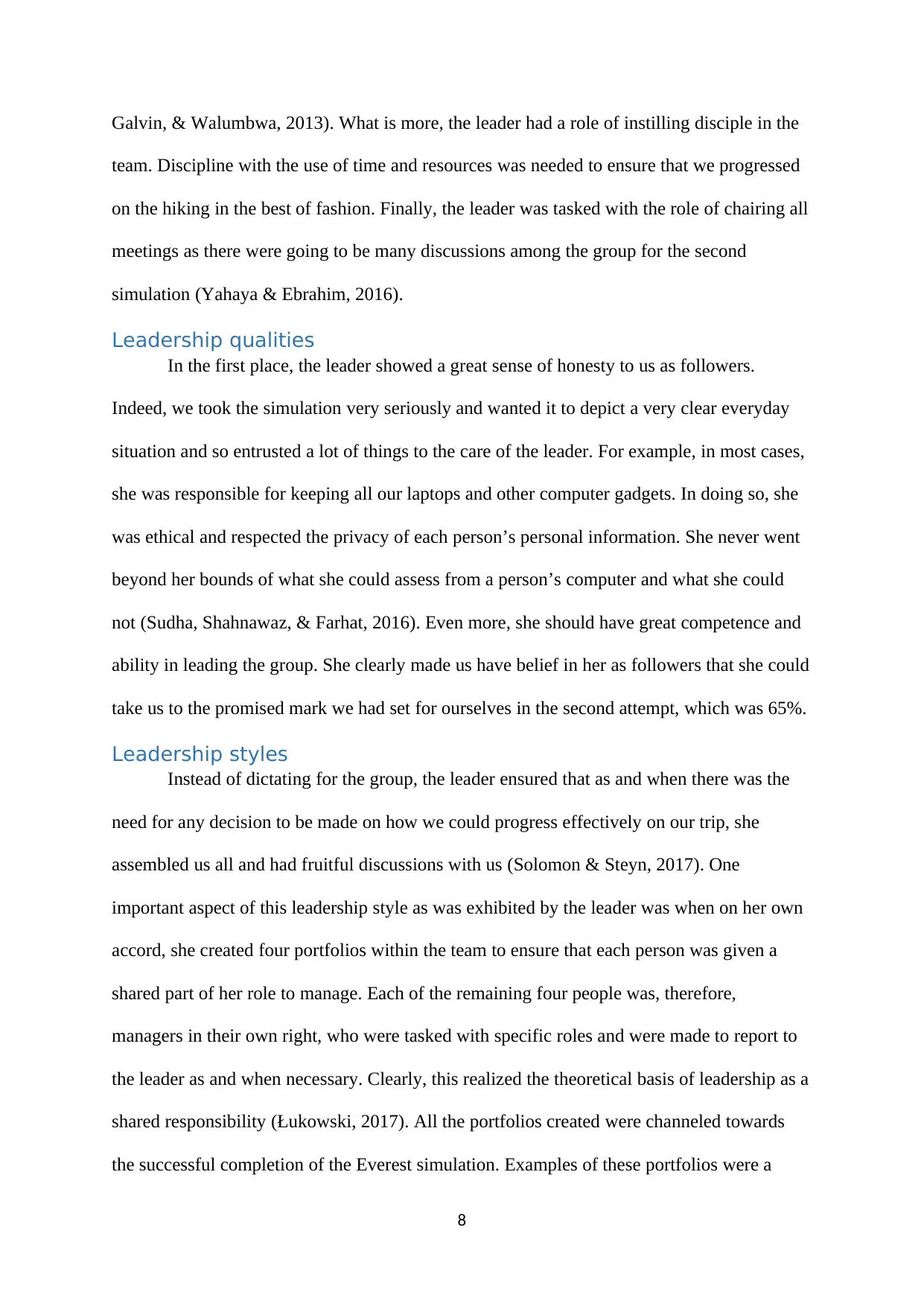
Galvin, & Walumbwa, 2013). What is more, the leader had a role of instilling disciple in the
team. Discipline with the use of time and resources was needed to ensure that we progressed
on the hiking in the best of fashion. Finally, the leader was tasked with the role of chairing all
meetings as there were going to be many discussions among the group for the second
simulation (Yahaya & Ebrahim, 2016).
Leadership qualities
In the first place, the leader showed a great sense of honesty to us as followers.
Indeed, we took the simulation very seriously and wanted it to depict a very clear everyday
situation and so entrusted a lot of things to the care of the leader. For example, in most cases,
she was responsible for keeping all our laptops and other computer gadgets. In doing so, she
was ethical and respected the privacy of each person’s personal information. She never went
beyond her bounds of what she could assess from a person’s computer and what she could
not (Sudha, Shahnawaz, & Farhat, 2016). Even more, she should have great competence and
ability in leading the group. She clearly made us have belief in her as followers that she could
take us to the promised mark we had set for ourselves in the second attempt, which was 65%.
Leadership styles
Instead of dictating for the group, the leader ensured that as and when there was the
need for any decision to be made on how we could progress effectively on our trip, she
assembled us all and had fruitful discussions with us (Solomon & Steyn, 2017). One
important aspect of this leadership style as was exhibited by the leader was when on her own
accord, she created four portfolios within the team to ensure that each person was given a
shared part of her role to manage. Each of the remaining four people was, therefore,
managers in their own right, who were tasked with specific roles and were made to report to
the leader as and when necessary. Clearly, this realized the theoretical basis of leadership as a
shared responsibility (Łukowski, 2017). All the portfolios created were channeled towards
the successful completion of the Everest simulation. Examples of these portfolios were a
8
team. Discipline with the use of time and resources was needed to ensure that we progressed
on the hiking in the best of fashion. Finally, the leader was tasked with the role of chairing all
meetings as there were going to be many discussions among the group for the second
simulation (Yahaya & Ebrahim, 2016).
Leadership qualities
In the first place, the leader showed a great sense of honesty to us as followers.
Indeed, we took the simulation very seriously and wanted it to depict a very clear everyday
situation and so entrusted a lot of things to the care of the leader. For example, in most cases,
she was responsible for keeping all our laptops and other computer gadgets. In doing so, she
was ethical and respected the privacy of each person’s personal information. She never went
beyond her bounds of what she could assess from a person’s computer and what she could
not (Sudha, Shahnawaz, & Farhat, 2016). Even more, she should have great competence and
ability in leading the group. She clearly made us have belief in her as followers that she could
take us to the promised mark we had set for ourselves in the second attempt, which was 65%.
Leadership styles
Instead of dictating for the group, the leader ensured that as and when there was the
need for any decision to be made on how we could progress effectively on our trip, she
assembled us all and had fruitful discussions with us (Solomon & Steyn, 2017). One
important aspect of this leadership style as was exhibited by the leader was when on her own
accord, she created four portfolios within the team to ensure that each person was given a
shared part of her role to manage. Each of the remaining four people was, therefore,
managers in their own right, who were tasked with specific roles and were made to report to
the leader as and when necessary. Clearly, this realized the theoretical basis of leadership as a
shared responsibility (Łukowski, 2017). All the portfolios created were channeled towards
the successful completion of the Everest simulation. Examples of these portfolios were a
8
⊘ This is a preview!⊘
Do you want full access?
Subscribe today to unlock all pages.

Trusted by 1+ million students worldwide
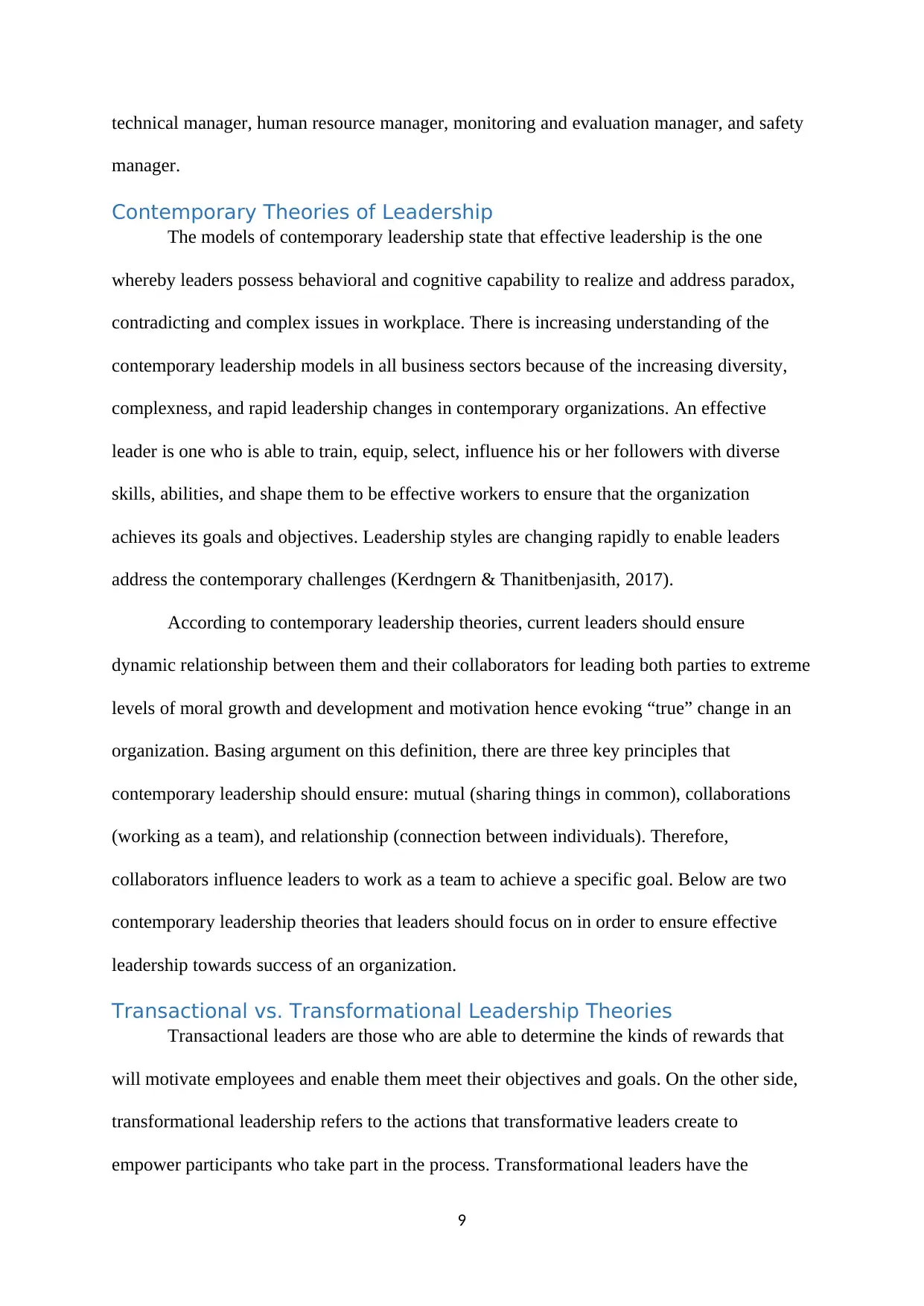
technical manager, human resource manager, monitoring and evaluation manager, and safety
manager.
Contemporary Theories of Leadership
The models of contemporary leadership state that effective leadership is the one
whereby leaders possess behavioral and cognitive capability to realize and address paradox,
contradicting and complex issues in workplace. There is increasing understanding of the
contemporary leadership models in all business sectors because of the increasing diversity,
complexness, and rapid leadership changes in contemporary organizations. An effective
leader is one who is able to train, equip, select, influence his or her followers with diverse
skills, abilities, and shape them to be effective workers to ensure that the organization
achieves its goals and objectives. Leadership styles are changing rapidly to enable leaders
address the contemporary challenges (Kerdngern & Thanitbenjasith, 2017).
According to contemporary leadership theories, current leaders should ensure
dynamic relationship between them and their collaborators for leading both parties to extreme
levels of moral growth and development and motivation hence evoking “true” change in an
organization. Basing argument on this definition, there are three key principles that
contemporary leadership should ensure: mutual (sharing things in common), collaborations
(working as a team), and relationship (connection between individuals). Therefore,
collaborators influence leaders to work as a team to achieve a specific goal. Below are two
contemporary leadership theories that leaders should focus on in order to ensure effective
leadership towards success of an organization.
Transactional vs. Transformational Leadership Theories
Transactional leaders are those who are able to determine the kinds of rewards that
will motivate employees and enable them meet their objectives and goals. On the other side,
transformational leadership refers to the actions that transformative leaders create to
empower participants who take part in the process. Transformational leaders have the
9
manager.
Contemporary Theories of Leadership
The models of contemporary leadership state that effective leadership is the one
whereby leaders possess behavioral and cognitive capability to realize and address paradox,
contradicting and complex issues in workplace. There is increasing understanding of the
contemporary leadership models in all business sectors because of the increasing diversity,
complexness, and rapid leadership changes in contemporary organizations. An effective
leader is one who is able to train, equip, select, influence his or her followers with diverse
skills, abilities, and shape them to be effective workers to ensure that the organization
achieves its goals and objectives. Leadership styles are changing rapidly to enable leaders
address the contemporary challenges (Kerdngern & Thanitbenjasith, 2017).
According to contemporary leadership theories, current leaders should ensure
dynamic relationship between them and their collaborators for leading both parties to extreme
levels of moral growth and development and motivation hence evoking “true” change in an
organization. Basing argument on this definition, there are three key principles that
contemporary leadership should ensure: mutual (sharing things in common), collaborations
(working as a team), and relationship (connection between individuals). Therefore,
collaborators influence leaders to work as a team to achieve a specific goal. Below are two
contemporary leadership theories that leaders should focus on in order to ensure effective
leadership towards success of an organization.
Transactional vs. Transformational Leadership Theories
Transactional leaders are those who are able to determine the kinds of rewards that
will motivate employees and enable them meet their objectives and goals. On the other side,
transformational leadership refers to the actions that transformative leaders create to
empower participants who take part in the process. Transformational leaders have the
9
Paraphrase This Document
Need a fresh take? Get an instant paraphrase of this document with our AI Paraphraser
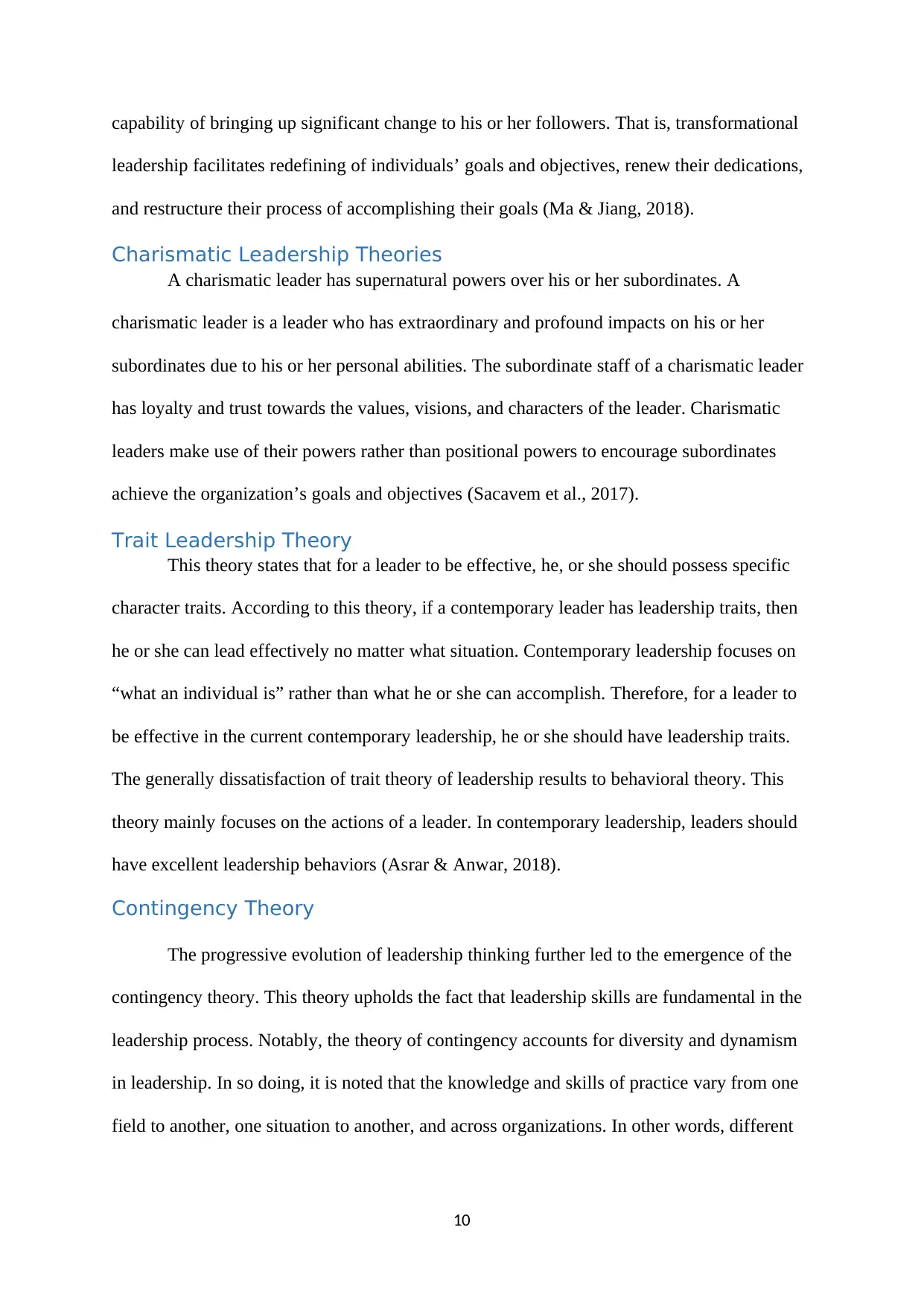
capability of bringing up significant change to his or her followers. That is, transformational
leadership facilitates redefining of individuals’ goals and objectives, renew their dedications,
and restructure their process of accomplishing their goals (Ma & Jiang, 2018).
Charismatic Leadership Theories
A charismatic leader has supernatural powers over his or her subordinates. A
charismatic leader is a leader who has extraordinary and profound impacts on his or her
subordinates due to his or her personal abilities. The subordinate staff of a charismatic leader
has loyalty and trust towards the values, visions, and characters of the leader. Charismatic
leaders make use of their powers rather than positional powers to encourage subordinates
achieve the organization’s goals and objectives (Sacavem et al., 2017).
Trait Leadership Theory
This theory states that for a leader to be effective, he, or she should possess specific
character traits. According to this theory, if a contemporary leader has leadership traits, then
he or she can lead effectively no matter what situation. Contemporary leadership focuses on
“what an individual is” rather than what he or she can accomplish. Therefore, for a leader to
be effective in the current contemporary leadership, he or she should have leadership traits.
The generally dissatisfaction of trait theory of leadership results to behavioral theory. This
theory mainly focuses on the actions of a leader. In contemporary leadership, leaders should
have excellent leadership behaviors (Asrar & Anwar, 2018).
Contingency Theory
The progressive evolution of leadership thinking further led to the emergence of the
contingency theory. This theory upholds the fact that leadership skills are fundamental in the
leadership process. Notably, the theory of contingency accounts for diversity and dynamism
in leadership. In so doing, it is noted that the knowledge and skills of practice vary from one
field to another, one situation to another, and across organizations. In other words, different
10
leadership facilitates redefining of individuals’ goals and objectives, renew their dedications,
and restructure their process of accomplishing their goals (Ma & Jiang, 2018).
Charismatic Leadership Theories
A charismatic leader has supernatural powers over his or her subordinates. A
charismatic leader is a leader who has extraordinary and profound impacts on his or her
subordinates due to his or her personal abilities. The subordinate staff of a charismatic leader
has loyalty and trust towards the values, visions, and characters of the leader. Charismatic
leaders make use of their powers rather than positional powers to encourage subordinates
achieve the organization’s goals and objectives (Sacavem et al., 2017).
Trait Leadership Theory
This theory states that for a leader to be effective, he, or she should possess specific
character traits. According to this theory, if a contemporary leader has leadership traits, then
he or she can lead effectively no matter what situation. Contemporary leadership focuses on
“what an individual is” rather than what he or she can accomplish. Therefore, for a leader to
be effective in the current contemporary leadership, he or she should have leadership traits.
The generally dissatisfaction of trait theory of leadership results to behavioral theory. This
theory mainly focuses on the actions of a leader. In contemporary leadership, leaders should
have excellent leadership behaviors (Asrar & Anwar, 2018).
Contingency Theory
The progressive evolution of leadership thinking further led to the emergence of the
contingency theory. This theory upholds the fact that leadership skills are fundamental in the
leadership process. Notably, the theory of contingency accounts for diversity and dynamism
in leadership. In so doing, it is noted that the knowledge and skills of practice vary from one
field to another, one situation to another, and across organizations. In other words, different
10
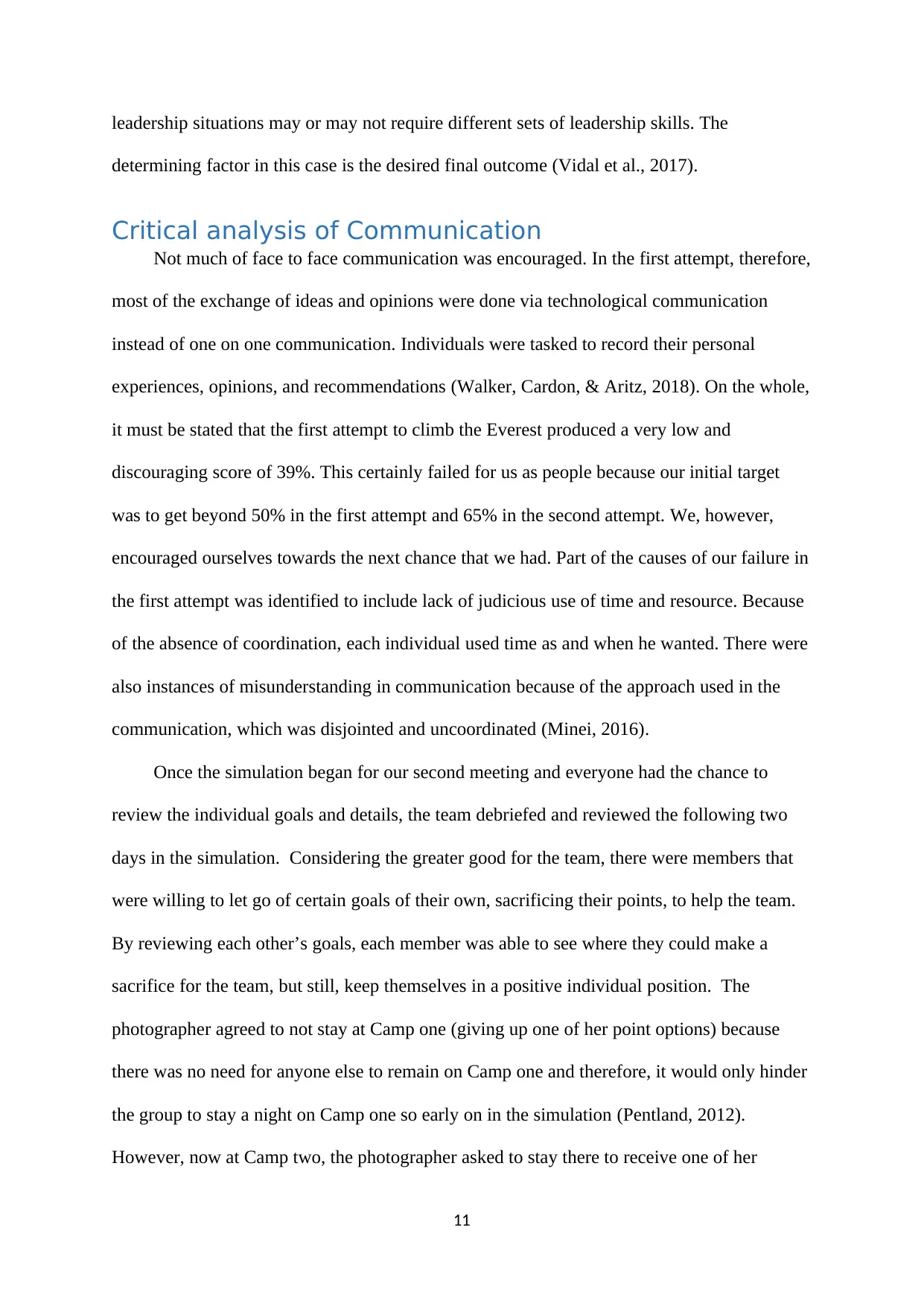
leadership situations may or may not require different sets of leadership skills. The
determining factor in this case is the desired final outcome (Vidal et al., 2017).
Critical analysis of Communication
Not much of face to face communication was encouraged. In the first attempt, therefore,
most of the exchange of ideas and opinions were done via technological communication
instead of one on one communication. Individuals were tasked to record their personal
experiences, opinions, and recommendations (Walker, Cardon, & Aritz, 2018). On the whole,
it must be stated that the first attempt to climb the Everest produced a very low and
discouraging score of 39%. This certainly failed for us as people because our initial target
was to get beyond 50% in the first attempt and 65% in the second attempt. We, however,
encouraged ourselves towards the next chance that we had. Part of the causes of our failure in
the first attempt was identified to include lack of judicious use of time and resource. Because
of the absence of coordination, each individual used time as and when he wanted. There were
also instances of misunderstanding in communication because of the approach used in the
communication, which was disjointed and uncoordinated (Minei, 2016).
Once the simulation began for our second meeting and everyone had the chance to
review the individual goals and details, the team debriefed and reviewed the following two
days in the simulation. Considering the greater good for the team, there were members that
were willing to let go of certain goals of their own, sacrificing their points, to help the team.
By reviewing each other’s goals, each member was able to see where they could make a
sacrifice for the team, but still, keep themselves in a positive individual position. The
photographer agreed to not stay at Camp one (giving up one of her point options) because
there was no need for anyone else to remain on Camp one and therefore, it would only hinder
the group to stay a night on Camp one so early on in the simulation (Pentland, 2012).
However, now at Camp two, the photographer asked to stay there to receive one of her
11
determining factor in this case is the desired final outcome (Vidal et al., 2017).
Critical analysis of Communication
Not much of face to face communication was encouraged. In the first attempt, therefore,
most of the exchange of ideas and opinions were done via technological communication
instead of one on one communication. Individuals were tasked to record their personal
experiences, opinions, and recommendations (Walker, Cardon, & Aritz, 2018). On the whole,
it must be stated that the first attempt to climb the Everest produced a very low and
discouraging score of 39%. This certainly failed for us as people because our initial target
was to get beyond 50% in the first attempt and 65% in the second attempt. We, however,
encouraged ourselves towards the next chance that we had. Part of the causes of our failure in
the first attempt was identified to include lack of judicious use of time and resource. Because
of the absence of coordination, each individual used time as and when he wanted. There were
also instances of misunderstanding in communication because of the approach used in the
communication, which was disjointed and uncoordinated (Minei, 2016).
Once the simulation began for our second meeting and everyone had the chance to
review the individual goals and details, the team debriefed and reviewed the following two
days in the simulation. Considering the greater good for the team, there were members that
were willing to let go of certain goals of their own, sacrificing their points, to help the team.
By reviewing each other’s goals, each member was able to see where they could make a
sacrifice for the team, but still, keep themselves in a positive individual position. The
photographer agreed to not stay at Camp one (giving up one of her point options) because
there was no need for anyone else to remain on Camp one and therefore, it would only hinder
the group to stay a night on Camp one so early on in the simulation (Pentland, 2012).
However, now at Camp two, the photographer asked to stay there to receive one of her
11
⊘ This is a preview!⊘
Do you want full access?
Subscribe today to unlock all pages.

Trusted by 1+ million students worldwide
1 out of 22
Related Documents
Your All-in-One AI-Powered Toolkit for Academic Success.
+13062052269
info@desklib.com
Available 24*7 on WhatsApp / Email
![[object Object]](/_next/static/media/star-bottom.7253800d.svg)
Unlock your academic potential
Copyright © 2020–2025 A2Z Services. All Rights Reserved. Developed and managed by ZUCOL.




